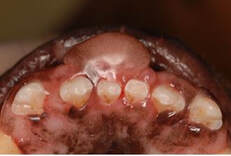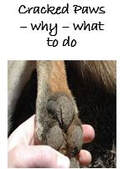|
Checking inside your dog's mouth, while brushing teeth, or at least on a weekly basis, will not only help with tooth health, you may also be able to detect an oral tumour developing, and get your dog early medical attention, as these tumours are often cancerous. Do have a look at the various Medical Insurance Plans we have available to find one that suits you. Please do not hesitate to contact us if any questions. www.genricpet.co.za
|
Oral Tumours in Dogs
www.vetspecialists.com - A fantastic website with articles written by professionals on all aspect of health
www.vetspecialists.com - A fantastic website with articles written by professionals on all aspect of health

Dogs and cats are frequently diagnosed with tumors of the oral cavity. This diverse group of cancers includes growths along the:
Some pets are diagnosed with oral tumors incidentally, meaning a growth is detected without the animal showing any clinical signs. Some owners may visualize a mass in their pet’s mouth while they are panting or yawning. Other owners may detect a problem while their animal is lying on their back with their mouth open in a position where their tongue falls away from the bottom jaw.
Oral tumors can also be detected during routine dental cleanings or while pets are undergoing anesthesia for an unrelated reason. Those procedures allow for a more thorough evaluation of the oral cavity, and every attempt should be made to use that experience to visualize an abnormality while an animal is anesthetized.
Oral tumors are typically diagnosed at a relatively advanced disease stage when they are causing significant clinical signs for the patient. This can include:
Diagnosis:
The most common oral tumors in dogs are melanoma, squamous cell carcinoma, and fibrosarcoma. In cats, the most common tumor is squamous cell carcinoma above all others. The diagnosis of an oral tumor will require a biopsy of the affected lesion to determine the tissue of origin. Fine needle aspirates can be done, however, this often requires sedation or anesthesia, and may not afford a definitive diagnosis, therefore surgical biopsy is the preferred method of choice. Biopsies may be excisional, which means the entire mass is removed and submitted for histopathology. Or they may be incisional, where a small piece of tissue is obtained. Many oral tumors invade into the underlying bones of the jaw/face and are difficult to remove entirely with a limited excisional biopsy, therefore in many cases, an incisional biopsy is recommended as the initial step. This allows for proper planning of a definitive surgery. In many cases, advanced imaging (CT scan or MRI) of the tumor should be done to determine its extent as well as for surgical planning.
Treatment & Aftercare
The treatment of choice for oral tumors in pets is surgical resection when possible. The feasibility of surgery will depend on several factors including:
When radiation therapy is performed following surgery, veterinary oncologists prescribe between 14 to 20 daily treatments administered over a several week period. This form of radiation therapy can lead to some significant, albeit temporary, side effects in pets due to the incorporation of surrounding healthy tissue within the region being irradiated. Side effects from radiation therapy in the oral cavity include ulceration of the oral tissue and skin and fur loss within the radiation field. A foul odor may develop as side effects occur in these areas and/or the tumor is destroyed by the radiation. This is usually temporary and decreases over time. If the eyes are included in the treatment field, the development of cataracts is possible.
Chemotherapy is variably effective for treating oral cancers in dogs and cats. Unfortunately, the most common oral tumors tend to be exceptionally resistant to this form of treatment. This means that when pets present with tumors that cannot be resected surgically due to size or location, the options are limited. Oral melanoma in dogs is a special scenario that can be treated with immunotherapy using a vaccine designed to target the patient’s immune system to attack residual cancer cells.
Prognosis
The prognosis for oral tumors will vary with a diagnosis. The prognosis for dogs diagnosed with oral melanoma varies with tumor size, location, the presence or absence of metastatic disease, and molecular markers of the tumor itself. Smaller, well-differentiated tumors located in the rostral (most forward) part of the mouth carry the most favorable prognosis, and complete surgical excision can be curative. Larger tumors may have a shorter prognosis (e.g. 6-12 months), and metastatic tumors carry the most guarded prognosis (< 6 months). The prognosis of dogs with oral squamous cell carcinoma varies with location in the mouth.
For tumors located along the gingiva (gums), complete excision can be curative, but will often require removal of the underlying bone. Tumors located along the tonsils have a higher metastatic rate and carry a guarded prognosis. The prognosis for dogs with oral fibrosarcomas is typically 10-12 months with surgery. The prognosis for cats with oral squamous cell carcinoma is generally poor. Tumors tend to be non-resectable at the time of diagnosis, and they are poorly responsive to other treatment modalities such as radiation therapy or chemotherapy and cats are typically only surviving a few weeks to months after diagnosis.
Prevention
There are no proven methods for preventing oral cancer in pets. However, earlier detection of disease would provide the best chance for long-term survival. Taking a look in your pet’s mouth once a month could aid in diagnosing oral tumors prior to their causing clinical signs. This task is easier said than done as many pets are not too happy about having their mouths fussed with.
A thorough oral exam should be part of every routine wellness exam for dogs and cats.
Veterinarians also struggle with successfully peeking in the mouths of our patients. However, we are generally more experienced with the process and also have more of an idea of what to look for and what could be concerning. When in doubt, it is generally very safe to administer a touch of a sedative to facilitate oral exams.
There are several clinical trials and many ongoing research studies for animals with oral tumors. Veterinary oncologists are the best reference point for owners looking for further information regarding this type of cancer, especially with reference to determining a pet’s eligibility for novel therapies. Owners can find additional information on oral tumors, their diagnosis, and surgical treatment options on the website for the Veterinary Society for Surgical Oncology.
- Gingiva (gum)
- Lips
- Tongue
- Tonsils
- Bone and cartilage of the upper and lower jaws
- Structural components holding the teeth in place
Some pets are diagnosed with oral tumors incidentally, meaning a growth is detected without the animal showing any clinical signs. Some owners may visualize a mass in their pet’s mouth while they are panting or yawning. Other owners may detect a problem while their animal is lying on their back with their mouth open in a position where their tongue falls away from the bottom jaw.
Oral tumors can also be detected during routine dental cleanings or while pets are undergoing anesthesia for an unrelated reason. Those procedures allow for a more thorough evaluation of the oral cavity, and every attempt should be made to use that experience to visualize an abnormality while an animal is anesthetized.
Oral tumors are typically diagnosed at a relatively advanced disease stage when they are causing significant clinical signs for the patient. This can include:
- Drooling (with or without evidence of bleeding)
- Halitosis (bad breath)
- Difficulty eating and/or drinking
- Facial swelling
- Signs of oral pain (pawing at the mouth or repeated opening/closing of the mouth)
Diagnosis:
The most common oral tumors in dogs are melanoma, squamous cell carcinoma, and fibrosarcoma. In cats, the most common tumor is squamous cell carcinoma above all others. The diagnosis of an oral tumor will require a biopsy of the affected lesion to determine the tissue of origin. Fine needle aspirates can be done, however, this often requires sedation or anesthesia, and may not afford a definitive diagnosis, therefore surgical biopsy is the preferred method of choice. Biopsies may be excisional, which means the entire mass is removed and submitted for histopathology. Or they may be incisional, where a small piece of tissue is obtained. Many oral tumors invade into the underlying bones of the jaw/face and are difficult to remove entirely with a limited excisional biopsy, therefore in many cases, an incisional biopsy is recommended as the initial step. This allows for proper planning of a definitive surgery. In many cases, advanced imaging (CT scan or MRI) of the tumor should be done to determine its extent as well as for surgical planning.
Treatment & Aftercare
The treatment of choice for oral tumors in pets is surgical resection when possible. The feasibility of surgery will depend on several factors including:
- Tumor size
- Patient size
- Specific location within the oral cavity
- Degree of invasiveness to underlying tissue
When radiation therapy is performed following surgery, veterinary oncologists prescribe between 14 to 20 daily treatments administered over a several week period. This form of radiation therapy can lead to some significant, albeit temporary, side effects in pets due to the incorporation of surrounding healthy tissue within the region being irradiated. Side effects from radiation therapy in the oral cavity include ulceration of the oral tissue and skin and fur loss within the radiation field. A foul odor may develop as side effects occur in these areas and/or the tumor is destroyed by the radiation. This is usually temporary and decreases over time. If the eyes are included in the treatment field, the development of cataracts is possible.
Chemotherapy is variably effective for treating oral cancers in dogs and cats. Unfortunately, the most common oral tumors tend to be exceptionally resistant to this form of treatment. This means that when pets present with tumors that cannot be resected surgically due to size or location, the options are limited. Oral melanoma in dogs is a special scenario that can be treated with immunotherapy using a vaccine designed to target the patient’s immune system to attack residual cancer cells.
Prognosis
The prognosis for oral tumors will vary with a diagnosis. The prognosis for dogs diagnosed with oral melanoma varies with tumor size, location, the presence or absence of metastatic disease, and molecular markers of the tumor itself. Smaller, well-differentiated tumors located in the rostral (most forward) part of the mouth carry the most favorable prognosis, and complete surgical excision can be curative. Larger tumors may have a shorter prognosis (e.g. 6-12 months), and metastatic tumors carry the most guarded prognosis (< 6 months). The prognosis of dogs with oral squamous cell carcinoma varies with location in the mouth.
For tumors located along the gingiva (gums), complete excision can be curative, but will often require removal of the underlying bone. Tumors located along the tonsils have a higher metastatic rate and carry a guarded prognosis. The prognosis for dogs with oral fibrosarcomas is typically 10-12 months with surgery. The prognosis for cats with oral squamous cell carcinoma is generally poor. Tumors tend to be non-resectable at the time of diagnosis, and they are poorly responsive to other treatment modalities such as radiation therapy or chemotherapy and cats are typically only surviving a few weeks to months after diagnosis.
Prevention
There are no proven methods for preventing oral cancer in pets. However, earlier detection of disease would provide the best chance for long-term survival. Taking a look in your pet’s mouth once a month could aid in diagnosing oral tumors prior to their causing clinical signs. This task is easier said than done as many pets are not too happy about having their mouths fussed with.
A thorough oral exam should be part of every routine wellness exam for dogs and cats.
Veterinarians also struggle with successfully peeking in the mouths of our patients. However, we are generally more experienced with the process and also have more of an idea of what to look for and what could be concerning. When in doubt, it is generally very safe to administer a touch of a sedative to facilitate oral exams.
There are several clinical trials and many ongoing research studies for animals with oral tumors. Veterinary oncologists are the best reference point for owners looking for further information regarding this type of cancer, especially with reference to determining a pet’s eligibility for novel therapies. Owners can find additional information on oral tumors, their diagnosis, and surgical treatment options on the website for the Veterinary Society for Surgical Oncology.





